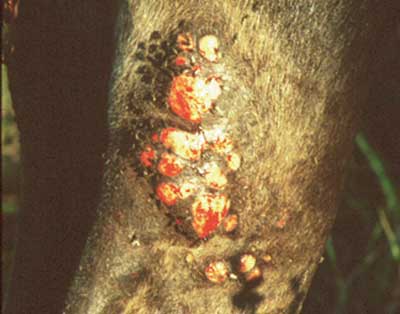Parasites and Diseases
Moose Fly
A Field Guide
TO COMMON WILDLIFE DISEASES
AND PARASITES IN ALASKA
MOOSE FLY

Bloody wounds on hind leg of moose due to fly bites
| What causes small open wounds on the hind legs of moose? |
- These wounds are caused by a biting fly commonly known as the “moose fly.” Its scientific name is Haematobosca alcis. Moose flies are slightly smaller than a common housefly.
| Where are the flies found? |
- The flies are found wherever moose are found in Alaska.
- Apparently, the flies do not attack other members of the deer family (such as deer, elk, or caribou).
| What are the signs of moose fly attacks? |
- The flies bite the hindquarters of moose just above the hock. Hundreds of flies may attack a moose at one time. The numerous bites produce wet open sores, measuring up to 1 inch in diameter. The wounds are often bloody.
| How can I protect myself? |
- The flies do not attack humans.
| Can I eat the meat? |
- Neither the flies nor the wounds affect the edibility of the meat in any way. The meat is safe to eat.
| Samples to collect |
- Report observations or submit photos.
- To report an occurrence or to submit a sample for identification/analysis, contact the DWC Wildlife Disease Surveillance reporting hotline 907-328-8354, send an email to dfg.dwc.vet@alaska.gov or visit your local ADF&G office.
